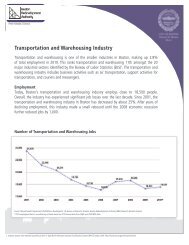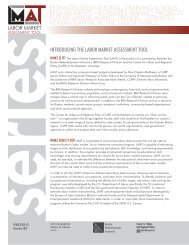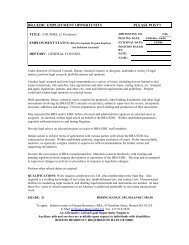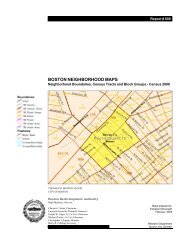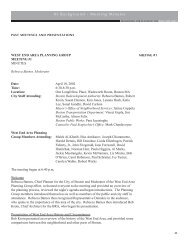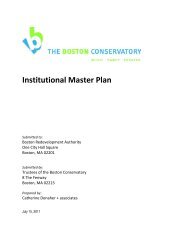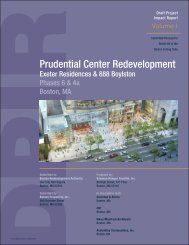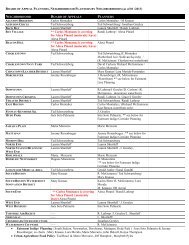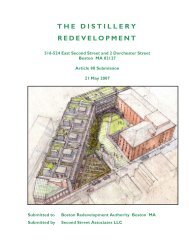point cover jan 13 - Boston Redevelopment Authority
point cover jan 13 - Boston Redevelopment Authority
point cover jan 13 - Boston Redevelopment Authority
Create successful ePaper yourself
Turn your PDF publications into a flip-book with our unique Google optimized e-Paper software.
Emission Rates<br />
\\MABOS\projects\1<strong>13</strong>81.00\reports\Article80\<br />
Expanded_PNF\04_Environmental_FINAL.do<br />
c<br />
Vanasse Hangen Brustlin, Inc.<br />
The Point, <strong>Boston</strong><br />
All the vehicle emission factors used in the microscale analysis were obtained using the EPA's MOBILE 6.2 7<br />
emissions model. MOBILE 6.2 calculates CO, PM10, and PM2.5 emission factors from motor vehicles in grams<br />
per vehicle-mile. The emission rates calculated in this study were adjusted to reflect Massachusetts-specific<br />
conditions, such as the state vehicle registration age distribution, the statewide Inspection and Maintenance<br />
(I/M) Program, and the Stage II Vapor Re<strong>cover</strong>y System. 8 Emission factors for the mobile sources were<br />
determined using the DEP-recommended temperatures for the winter (CO) season and summer (PM) season.<br />
Traffic Data<br />
The air quality study utilized motor vehicle traffic data specifically developed for each analysis condition.<br />
The Build Condition used for the microscale analysis includes the physical and operational mitigation<br />
proposed to improve traffic operations. The microscale analysis used the evening peak hour traffic conditions<br />
during the CO season (winter). Vehicle speeds were developed based upon traffic volumes, observed traffic<br />
flow characteristics, and roadway capacity. The traffic data were developed based on the traffic study<br />
presented in Chapter 3, Transportation of this PNF report.<br />
<br />
Existing Air Quality Conditions<br />
The CAAA resulted in states being divided into attainment and non-attainment areas, with classifications<br />
based upon the severity of their air quality problems. The Project is located in the <strong>Boston</strong> Metropolitan area,<br />
which has been classified as a “Maintenance” area for CO and an attainment area for PM10 and PM2.5.<br />
The microscale analysis determined that the 1-hour CO concentrations for the 2012 Existing Condition ranged<br />
from a minimum of 4.2 parts per million (ppm) at the intersection of Boylston Street at Yawkey Way to a<br />
maximum of 6.3 ppm at the intersection of Brookline Avenue at Fenway. The corresponding maximum<br />
8-hour CO concentrations ranged from a minimum of 2.9 ppm to a maximum of 4.4 ppm. The microscale CO<br />
results are presented in Table 4-3 and Table 4-4 (presented below). All the 1-hour and 8-hour concentrations<br />
are below the CO NAAQS of 35 and 9 ppm, respectively. These values are consistent with the area’s<br />
designation as a CO Maintenance area.<br />
The microscale analysis determined that the 24-hour PM10 concentrations for the 2012 Existing Condition<br />
ranged from a minimum of 41.3 micrograms per cubic meter (ug/m 3 ) at the intersection of Brookline Avenue<br />
at Kilmarnock Street and the intersection of Boylston Street at Kilmarnock Street to a maximum of 43.3 ug/m 3<br />
at the intersection of Brookline Avenue at Fenway. The microscale PM10 results are presented in Table 4-5<br />
(presented below). All concentrations are below the PM10 NAAQS of 150 ug/m 3 .<br />
The microscale analysis determined that the 24-hour PM2.5 concentrations for the 2012 Existing Condition<br />
ranged from a minimum of 23.1 ug/m 3 at the intersection of Brookline Avenue at Kilmarnock Street and the<br />
<br />
5 MOBILE 6.2 (Mobile Source Emission Factor Model), The May 19, 2004 official release from US EPA, Office of<br />
Mobile Sources, Ann Arbor, MI.<br />
6 The Stage II Vapor Re<strong>cover</strong>y System is the process of collecting gasoline vapors form vehicles as they are refueled.<br />
This requires the use of a special gasoline nozzle at the fuel pump.<br />
4-19 Environmental Protection



